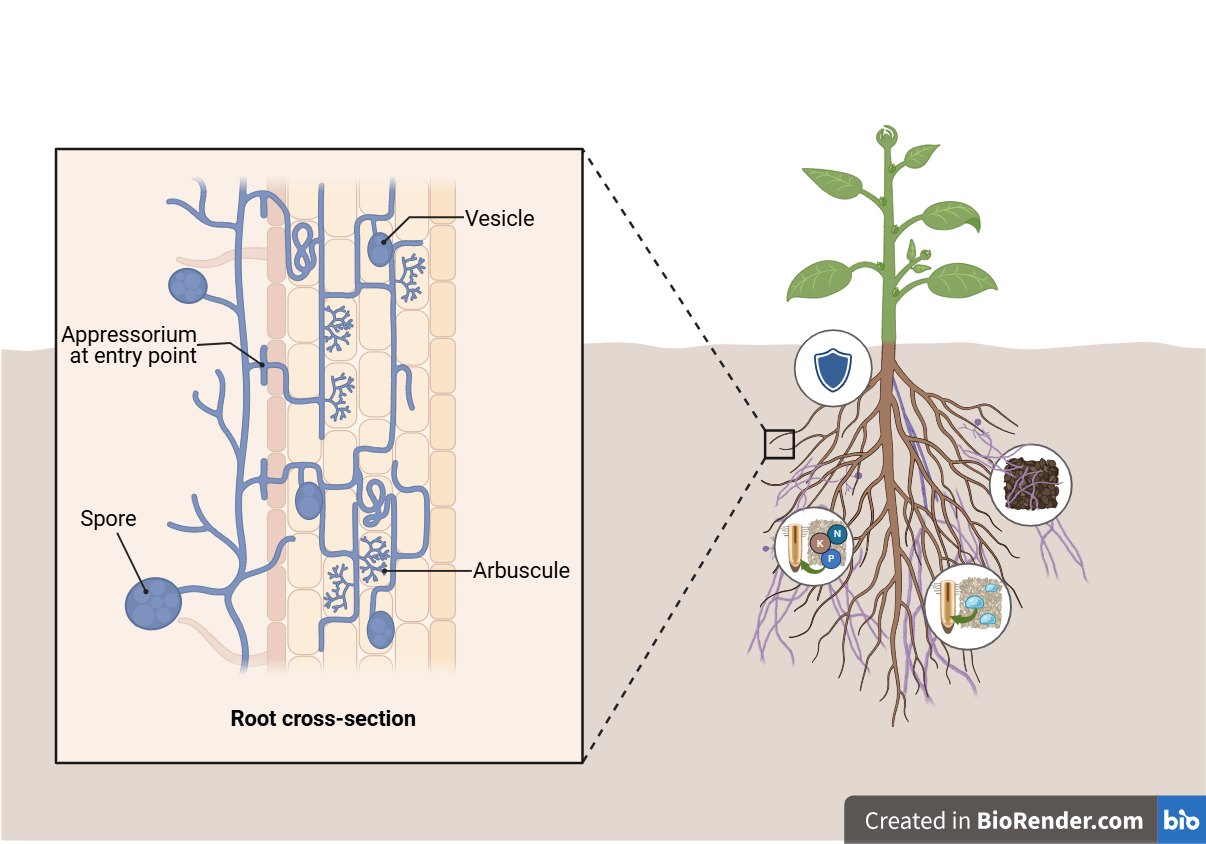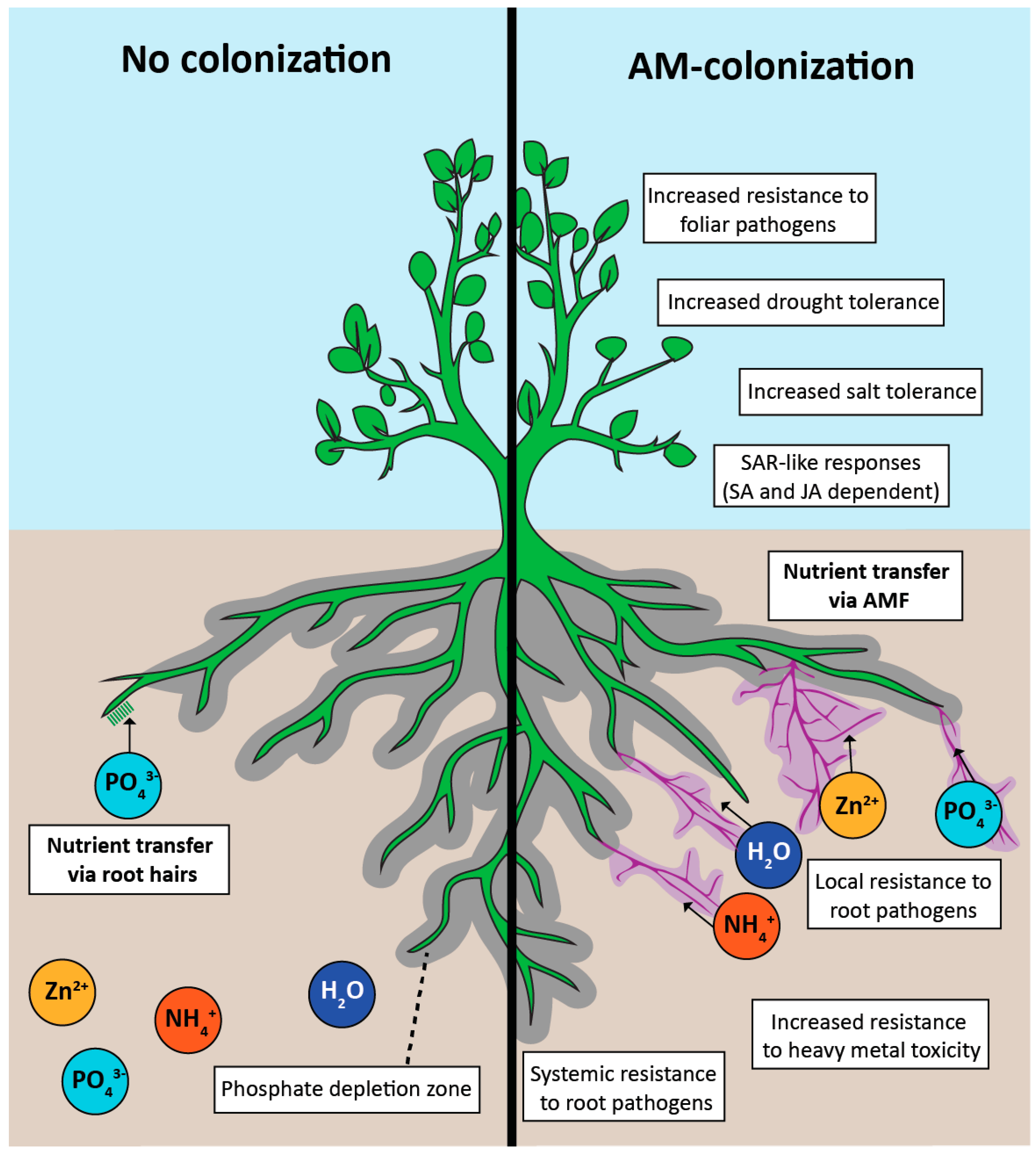Introduction
Imagine preparing a soup without water: you can have the best ingredients, but nothing cooks properly. Plants face a similar challenge when the soil is dry: they can’t photosynthesise their growth without water and nutrients. Climate change means that these dry spells are becoming more common, putting agriculture under great stress, but plants are not alone in this struggle.
Beneath our feet, in the soil, there is a living network of microorganisms that help crops withstand hardship. Among them, arbuscular mycorrhizal fungi (often shortened to AMF) are like invisible partners, forming microscopic connections with plant roots. You won’t see them with the naked eye when you walk through a field or garden, but they have been supporting plants for millions of years, some say that ever since the first plants colonised land. Today, they may hold part of the answer to making farming more resilient in a changing climate.
What are mycorrhizal fungi, and why should we care?
Think of mycorrhizal fungi as “extra roots” for plants. When they attach to roots, they spread thin filaments into the soil, reaching far beyond where roots can go. This partnership is a true exchange: the plant provides the fungus with sugars and lipids coming from photosynthesis, and the fungus facilitates the absorption of water and nutrients like phosphorus and nitrogen to the plant.
It’s a win-win relationship, since these fungi can’t live without the host plants. In fact, around 80% of all plants in the world use these fungi as helpers. Without them, many crops would struggle to find enough resources to grow, especially in dry or poor soils. For farmers, this means healthier crops with less dependence on synthetic fertiliser.
 Arbuscular mycorrhizal fungal structures in the root and benefits for crops. Spores are thick-walled, multi-nucleate reproductive structure that form in the soil or in roots to help the fungus multiply and persist; appressorium is the “infection structure” that hyphae form on root epidermis to penetrate it and start colonization; arbuscules are the highly branched structures they form inside the roots for nutrient exchange with the plant; vesicles are only formed by some fungal species and they have been suggested to be involved in inter-organismal communication. This symbiosis provides several benefits for crops, including and improved soil structure, which helps with water and nutrient retention; therefore, they also facilitate their absorption; additionally, they provide communication between different individuals, providing improved defence against pests.
Arbuscular mycorrhizal fungal structures in the root and benefits for crops. Spores are thick-walled, multi-nucleate reproductive structure that form in the soil or in roots to help the fungus multiply and persist; appressorium is the “infection structure” that hyphae form on root epidermis to penetrate it and start colonization; arbuscules are the highly branched structures they form inside the roots for nutrient exchange with the plant; vesicles are only formed by some fungal species and they have been suggested to be involved in inter-organismal communication. This symbiosis provides several benefits for crops, including and improved soil structure, which helps with water and nutrient retention; therefore, they also facilitate their absorption; additionally, they provide communication between different individuals, providing improved defence against pests.
How do fungi help plants during drought?
Picture walking across a desert with a friend who carries extra water bottles hidden in their backpack. That is what AM fungi do for plants under drought. Their fine filaments reach tiny pockets of water in the soil that roots alone can’t access. By channelling this hidden water to the plant, fungi make crops more resistant to dry spells. And that’s not all. These fungi also improve soil structure, binding soil particles into small clumps. That makes the soil act like a sponge, holding water longer after rainfall or irrigation. In the long run, this means less water is wasted and plants can “sip” from the soil for a longer time.
 Positive effects of arbuscular mycorrhizal (AM) colonization The hyphal network of arbuscular mycorrhizal fungi (AMF) extends beyond the plant’s root depletion zone (grey), allowing greater access to soil phosphates. Over time, a phosphate depletion zone also forms around the AM hyphae (purple). In addition to improved phosphate uptake, AM-colonized roots show enhanced assimilation of nutrients such as nitrogen (ammonium) and zinc. Mycorrhizal colonization also boosts plant tolerance to various abiotic and biotic stresses by triggering systemic acquired resistance (SAR).
Positive effects of arbuscular mycorrhizal (AM) colonization The hyphal network of arbuscular mycorrhizal fungi (AMF) extends beyond the plant’s root depletion zone (grey), allowing greater access to soil phosphates. Over time, a phosphate depletion zone also forms around the AM hyphae (purple). In addition to improved phosphate uptake, AM-colonized roots show enhanced assimilation of nutrients such as nitrogen (ammonium) and zinc. Mycorrhizal colonization also boosts plant tolerance to various abiotic and biotic stresses by triggering systemic acquired resistance (SAR).
If fungi are so helpful, why isn’t every farm already using them?
Here’s where it gets tricky. Modern agriculture, with its heavy ploughing, chemical fertilisers, and monocultures, often disrupts these delicate fungal networks and make plants less dependent of this symbiosis. Tillage, for example, breaks apart the fungal threads, while some fertilisers reduce the diversity of fungi in the soil. Over decades, this has led to a silent erosion of underground biodiversity.
The good news is that farmers and scientists are exploring ways to bring fungi back into the picture. Practices like rotating crops, reducing ploughing, adding organic matter, or planting cover crops can protect and promote mycorrhizal fungi. Organic farming places a strong emphasis on these methods: instead of relying on synthetic fertilisers and pesticides, it nurtures soil life through compost, manure, green manures, and diverse crop rotations. This approach creates a more favourable environment for fungi, which can improve soil fertility and resilience in the long run. In some cases, farmers even use fungal “biofertilizers”, though the most promising results often come from encouraging the native fungi already living in the soil.

Conclusion
Next time you see a golden wheat field or a tomato plant in your garden, remember that their survival might depend not only on rain and sunshine but also on a hidden partnership underground.
Mycorrhizal fungi are unsung heroes of agriculture: they help plants grow stronger, save water, and endure drought. In the face of climate change, taking care of these invisible allies could mean taking care of our own food security.







Rate and Review
Rate this article
Review this article
Log into OpenLearn to leave reviews and join in the conversation.
Article reviews